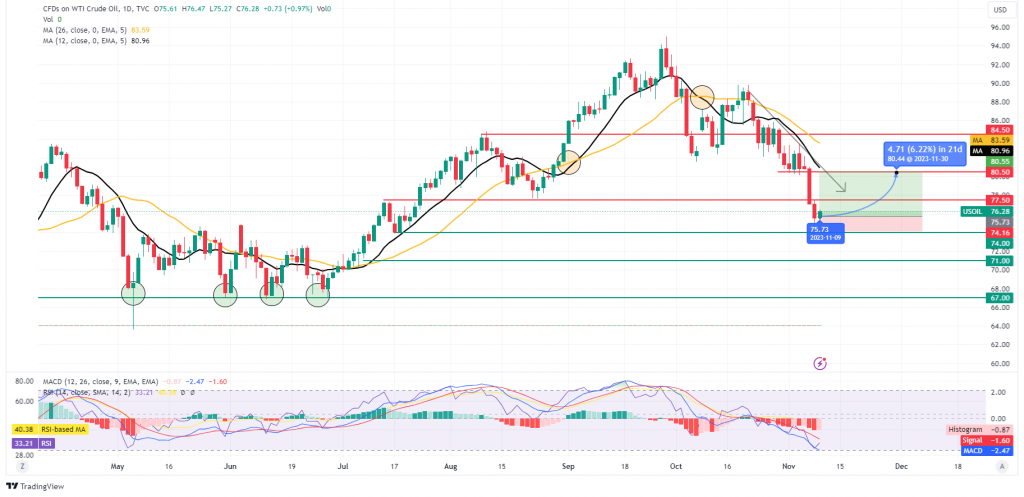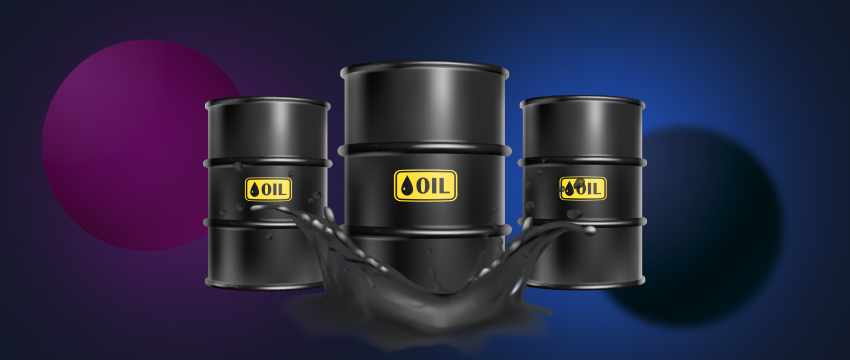Crude futures dropped below the $75 per barrel level in today’s session and revisited an area last seen before in the later stages of July of 2023, as demand concerns stemming from both the US and China, the two largest oil consuming nations in the world, outweigh the impact of output supply restrictions set in place by Saudi Arabia and Russia. In addition, fears for a possible escalation of tensions across Middle East tempered, leading energy traders to downwardly revise their targets. This report aims at analysing the fundamental drivers influencing WTI’s price action and seeks to assess its future outlook and conclude with a technical analysis.

Global demand worried cloud the horizon for crude bulls
Earlier this week, China’s mixed trade data results clouded the horizon for a strong comeback from the Red Giant, raising concerns in the eyes of investors and placed another hurdle in its path for a smooth recovery process. The inability of Chinese exports at escaping their negative spiral and snapping their months long shrinking streak, alongside the nations sluggish manufacturing capabilities, signals depleted demand needs from the world’s top crude importer, which is what the bears capitalized upon and weighed on the commodity.
Another factor that aggravated the fall yesterday and added more fuel to the fire, were the reported inventory figures from the American Petroleum Institute. The agency showcased that over the past week US crude stockpiles have sharply risen to almost 12 million barrels and recorded their biggest pileup since the start of this year. Huge pileups are a bad omen for traders since they are a direct indication for a lack of demand. Furthermore, EIA’s monthly report showcased that the agency foresees a larger than initially forecasted shortfall in consumption of petroleum from US consumers for the remainder of this year. API revised higher their former 100,000 bpd projection for a decline in US crude consumption to 300,000 bpd, foreseeing a deeper drag in demand.
Supply restrictions get sidelined
The effect of the voluntary output cuts from Saudi Arabia and Russia have worn out since the start of November. This past Sunday, Saudi Arabia and Russia, OPEC+ top brass, communicated that no additional restrictions would take place for the remainder of the year, keeping their pledge to limit supply at the aforementioned levels intact, which left disappointed energy bulls, who have set their crosshairs onto a $100 per barrel crude by the end of the year.
Situation in Middle East and World Bank’s forecasts
Over the past few weeks, the worries of a possible overspill of war between Israel and Hamas across the Middle East soothed and nudged traders to reassess their overoptimistic outlooks. Israel allowing the evacuation of civilians from the now encircled central Gaza city and the entry of humanitarian aid, caused a rise in optimism that the conflict could be contained within the boarders, preventing its spread in neighbouring countries and avoiding in a sense the disruption of crude supply from the nearby oil rich region.
Furthermore, the World Bank dared to forecast that should the conflict does not spill in the wider region, crude oil prices could average out around the $90 per barrel range in Q4 of 2023 and subsequently drop to $81 per barrel in 2024. However, under its worst-case scenario forecasts, where the conflict escalates and cause wide oil disruptions, the organisation foresees an upshot of crude prices near the $150 per barrel, irrespective of global growth trends of the world’s largest economies.
Oil Technical Analysis
WTI Cash H4

Looking at WTI Daily chart we observe that crude prices broke below the $77.50 prior support base now turned resistance and dropped into 4 months low territory, whereas in today’s session the commodity trends in the greens and attempts to consolidate around the $75 per barrel range. Despite clear bearish indications, we hold the view that the commodity has reached overextension levels and a correction higher may be brewing under the surface, forming the next higher low from a medium-term-horizon point of view. The MACD indicator below our daily chart has yet to show signs of a tide shift, whereas the RSI indicator registers a value of 33 and is on a collision course with the 30 oversold threshold bound.
We thus hold a bullish bias for crude, however, in order to gain outmost confidence in our bullish case, we would require seeing the MACD line definitively crossing the signal line, alongside dwindling histogram bars showcasing a fadeout of momentum, and the RSI indicator forming a base and bouncing from the 30 level, pivoting away from excess bearish sentiment. Shall the bulls take the initiative and take over control of the direction of the commodity, we may see crude breaking past the $77.50 (R1) resistance level and turning into support, facilitating its move close to the $80.50 (R2) resistance barrier. Should on the other hand, the bears stay in control, we would reasonably expect to see the break below the $74.00 (S1) support level, and the subsequent move towards the $71.00 (S2) support base, an area last seen in mid-July of 2023, erasing entirely the gains of crude in Q2 of 2023.
免责声明: This material is for general informational & educational purposes only and should not be considered as investment advice or an investment recommendation. T4Trade is not responsible for any data provided by third parties referenced or hyperlinked, in this communication.


